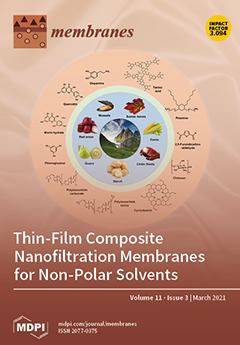A high-silica chabazite (CHA) type zeolite membrane was prepared on the porous α-Al
2O
3 support tube by the secondary growth of seed particles. The dehydration performances of the membrane were determined using methanol, ethanol, 2-propanol, acetone, acetic acid, methyl ethyl ketone
[...] Read more.
A high-silica chabazite (CHA) type zeolite membrane was prepared on the porous α-Al
2O
3 support tube by the secondary growth of seed particles. The dehydration performances of the membrane were determined using methanol, ethanol, 2-propanol, acetone, acetic acid, methyl ethyl ketone (MEK), tetrahydrofuran (THF),
N,N-dimethylformamide (DMF), dimethyl sulfoxide (DMSO), and
N-methyl-2-pyrolidone (NMP) at 303–373 K. As a result, the dehydration performances of the membrane were categorized to following three types: (1) 2-propanol, acetone, THF, and MEK; (2) ethanol and acetic acid; and (3) methanol, DMF, and DMSO, and NMP. The adsorption isotherms of water, methanol, ethanol, and 2-propanol were determined to discuss the influences of the organic solvents on the permeation and separation performances of the membrane. For 2-propanol, acetone, MEK, and THF solutions, the high permeation fluxes and separation factors were obtained because of the preferential adsorption of water due to molecular sieving. In contrast, the permeation fluxes and separation factors were relatively low for methanol, DMF, and DMSO, and NMP solutions. The lower dehydration performance for the methanol solution was due to the adsorption of methanol. The permeation fluxes for ethanol and acetic acid solution were ca. 1 kg m
−2 h
−1. The significantly low flux was attributed to the similar molecular diameter to the micropore size of CHA-type zeolite.
Full article






